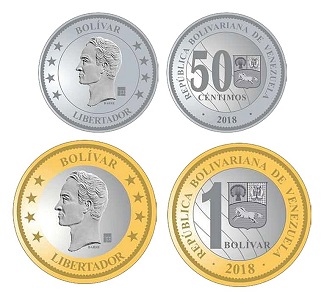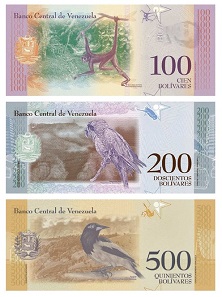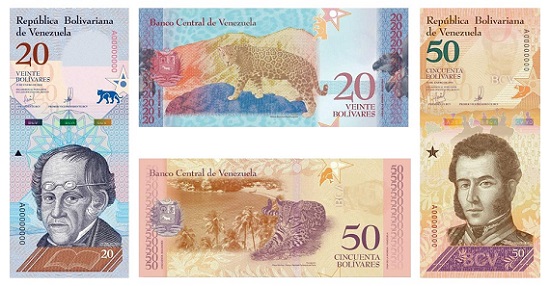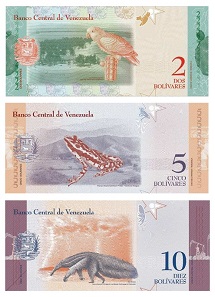By Michael Alexander
August 30, 2018 – The Banco Central de Venezuela have introduced their new Bolivar Soberano or Sovereign Bolivar on August 20, 2018 to weary Venezuelan public amid uneasy social and economic conditions. The currency was launched on what was announced as a national holiday for a people who have been coping with a staggeringly high rate of inflation resulting in the real loss of value of their currency by the day. The new or re-valued currency was initially announced earlier this year but had been postponed due to the greater level of inflation which has been plaguing the country’s economy. When the re-valuation of the Bolivar Fuerte was announced, the Central Bank had proposed shedding three zeroes from the current banknotes – the largest denomination being 100,000 Bolivar Fuertes. As inflation and the black market in the currency’s exchange continued on an upward trend, the Central Bank postponed the revised currency’s introduction by three months and announced there would be five zero’s removed from the present system of money – thus 100,000 Bolivar Fuertes would equate to one new Bolivar Soberano.
Along with eight banknotes, two new coins have been introduced. Sourced from the website of the Banco Central de Venezuela – public domain.
The eight new banknote values are uniform in size at 69 / 156 mm, vary in colour with different denominations and depict similar historic personalities depicted on the obverse and reverse designs of indigenous animal life seen on both the 2008 and 2016 banknote series. They range in values from 2 to 500 Bolivar Soberanos and also retain their vertical design concept, seen on the obverse side. In addition to the banknotes, just two coins are also being introduced in values of 1 Bolivar (100,000 Bolivar Fuertes) and 50 centavos (50,000 Bolivare Fuertes)
The new banknotes depict important Venezuelan personalities like Ezequiel Zamora (100 VES) and Francisco de Miranda (200 VES). Sourced from the website of the Banco Central de Venezuela – public domain.
At the beginning of August, the country’s president Nicholas Maduro appeared on television and displayed the new banknotes while explaining their value is being guaranteed by the transfer to the Central Bank of one of the country’s largest oil reserve fields. This move, coupled with the creation of a crypto currency – the “petro” is seen by the Maduro government as guaranteeing that the new Bolivar Soberano does not lose its stated value.
With the introduction of the Bolivar Soberano (new ISO code VES) the Central Bank has effectively recognised that the black market’s exchange rate for the Bolivar Fuerte which reached nearly 6 million units per USD. By adopting a practical and official rate of what will amount to 60 Bolivar Soberanos equalling one US Dollar is seen by most economists to be more realistic exchange rate. This equation was calculated by the National Executive, taking into consideration the value of the country’s new crypto-currency the petro. The government has adopted this new mode of accounting which is based on the daily trade price of a barrel of oil, hovering at just under 60 Dollars. As such, the exchange rate between the new Bolivar Soberano equalling 3600 per petro calculates to an exchange rate of 60 Bolivar soberanos per USD. In conjunction with the introduction of the new currency, the Government has also announced that all businesses with more than ten employees must pay a monthly salary of 1800 Bolivar Soberanos or, USD$30.
Some background about the revised currency – why was the change necessary?
Within the last decade, Venezuela has gone from being one of Latin America’s most healthy economies to its most ailing. The re-named Bolivarian Republic of Venezuela has seen three separate currency systems in use since the introduction of the first version of the Bolivar in 1940 until today. Why or more important, how is it that a country which was once economically prosperous would need to essentially re-issue or re-value their currency for a second time in in less than nineteen years?
The reverse of the Bolivar Soberano depicts indigenous animals of Venezuela, for example the Brown spider monkey (100 VES). Sourced from the website of the Banco Central de Venezuela – public domain.
On the other side of the coin, Venezuela is quite wealthy in terms of its natural resources and what this could eventually mean to the lives of its 31 million citizens. With an oil reserve which has been recognised as one of the greatest on the planet, Venezuelans should be living a very comfortable life. However, the mismanagement of a once-thriving economy with unsustainable policies of price controls, nationalisation of vital industries, subsidies, excessive borrowing and over-spending have shattered the lives of many. Much of what has been a consistent string of mismanagements in terms of the country’s economy has been credited to the election of the late Hugo Chavez (1954 – 2013) in 1998 as president. His government pursued Socialist/Marxist policies which favoured a tighter control of the economy as it is almost completely reliant of oil exports. In 2003, Chavez began implementing price controls in the private sector, the labour market and subsidised prices for consumer goods and services which quickly resulted in inflation and the government needing to borrow heavily to fund public works projects. The currency, the Bolivar – so named after the country’s national hero Simon Bolivar, began to show tacit signs of stress with higher inflation and a weaker exchange rate internationally.
On the 1st January 2008 President Chavez announced new currency – the “Bolivar Fuerte” or strong Bolivar would be introduced to replace the previous Bolivar, dissolved by runaway inflation. The new Bolivar Fuerte saw the removal of three zero’s from the previous banknotes and was pegged at an official rate of exchange rate against the US Dollar at 6.12 – offering a brief period of respite from a rate of inflation which stood at 20%.
With the death of Hugo Chavez in 2013, who had been controversially re-elected to a fourth term as President in 2012 coupled with the world-wide decrease in the price of crude oil in 2014, the economy of Venezuela was facing further stagnation and an actual decrease in its overall GDP. By 2017 the Venezuelan economy decreased by a shocking 35% from their previous levels recorded in 2013 and the country’s overall GDP per capita had shrunk by an appalling 40%.
Chavez’s successor, Nicholas Maduro continued his predecessor’s failed economic policies which saw the rate of inflation recorded at an eye-watering 13,500% and a currency which lost the confidence of the public. In place of a means of payment, bartering with containers of milk and eggs became a form of exchange or money. Prices were for the most part doubling in a 24 hour period for some foods and other essentials. The International Monetary Fund had warned Caracas that it could actually see inflation at one million percent within the year if their current conditions continue unabated.
The 20 VES and 50 VES notes show philosopher Simón Rodríguez and Antonio José de Sucre, a Venezuelan independence leader. Sourced from the website of the Banco Central de Venezuela – public domain.
The Bolivar Fuerte is now completely worthless with actual banknotes littering the streets of many cities and towns since the money no longer represents value. Commercial banks allowed a very small withdrawal with customers having to line up for hours for essentially pennies worth of Bolivar Fuertes – often not enough to buy even the smallest subsidised foodstuffs or parcels. By late 2016, president Maduro ordered the recall of all lower denominations of the Bolivar fuerte – exempting the 100 Bolivar notes and by the end of 2016, six new banknote denominations were planned for introduction. The new notes ranged in face values of 500 to 20,000 Bolivar Fuertes which only alleviated the need to carry hundreds of 100 Bolivar notes to shop for the simplest of goods. Ultimately a 100,000 Bolivar note was issued but this face value too had little impact on the runaway inflation rate and very shortly this note could purchase not more than a small piece of fruit.
The “Band-aid effect”
While announcing the plans to re-denominate the currency, bring inflation to heel and re-structure the economy, President Maduro attempted to give actual value to this new currency by having taken the unprecedented step of signing over one the country’s most potentially lucrative oil field over to the Banco Central de Venezuela. Despite the Bank’s lack of sovereignty from the government, Maduro placed its ownership under the auspices of the Bank in an effort to take the place of foreign currency reserves or bullion holdings many central Banks depend on to give their money some modicum of value. Maduro also linked the value of the new Bolivar Soberano to the newly created “crypto-currency, the “petro” whose value is directly connected to a barrel of oil and its price on the international commodities exchange. The President also announced the introduction of a “Fatherland card” which entitles the holder, roughly half the population to continued subsidies on living essentials, including fuel while those who do not qualify for this card will pay market value for their needs. Most economists have criticised these moves as nothing more than a band-aid which will simply not alleviate the chronic conditions of the country’s run-away inflation rate.
The banknotes of smaller face value, too, show indigenous animals of Venezuela. Sourced from the website of the Banco Central de Venezuela – public domain.
The government’s policies of subsidies and rigid price controls as well as their refusal to accept foreign aid have worsened the situation. Maduro’s government are also unable to access foreign bond markets to borrow since they have defaulted on bond interest payments and are now considered an unsafe market. Amidst all of this political and economic unrest, the new Bolivare Sobrano – or Sovereign Bolivar has now been introduced. While the government tries to refinance and restructure its sky-high external debts, confidence that the plan of linking its national currency to its new crypto-currency – will have almost no chance of succeeding. The economy is expected to contract further this year and into 2019, deepening the economic catastrophe in the country.
The author, Michael Alexander is president of the London Banknote and Monetary Research Centre.
This video published by the Daily Mail shows President Maduro’s announcement.








